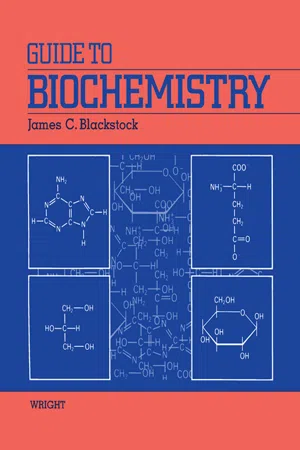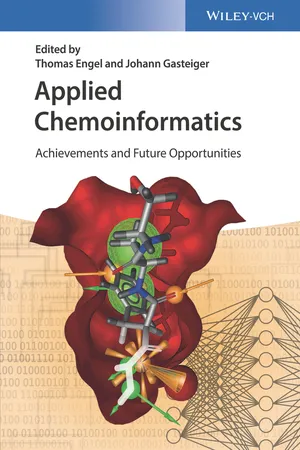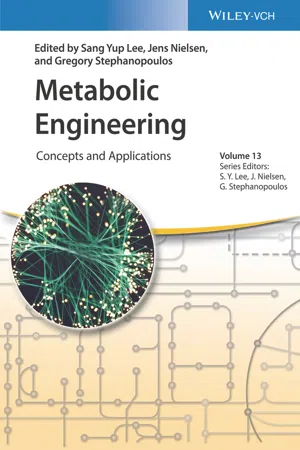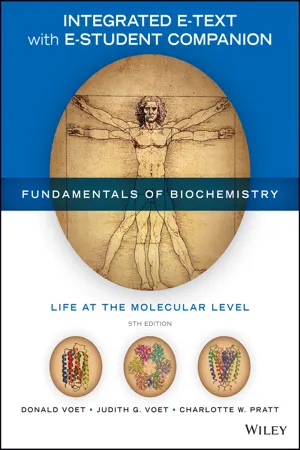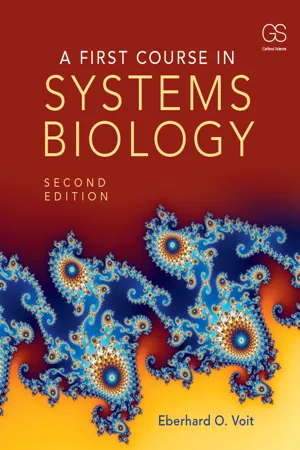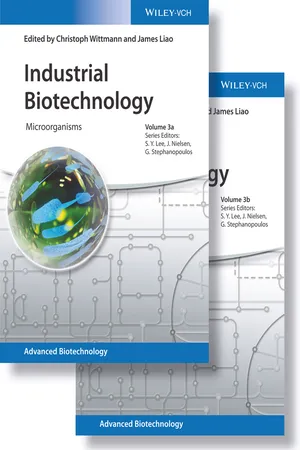Biological Sciences
Metabolic Pathways
Metabolic pathways are a series of chemical reactions that occur within a cell, leading to the transformation of molecules. These pathways are crucial for the production of energy, synthesis of essential molecules, and the breakdown of nutrients. They are tightly regulated and interconnected, forming a complex network that enables the cell to maintain homeostasis and carry out its functions.
Written by Perlego with AI-assistance
Related key terms
Related key terms
1 of 4
Related key terms
1 of 3
8 Key excerpts on "Metabolic Pathways"
- eBook - ePub
Mathematical Concepts and Methods in Modern Biology
Using Modern Discrete Models
- Raina Robeva, Terrell Hodge(Authors)
- 2013(Publication Date)
- Academic Press(Publisher)
Chapter 8 Metabolic Pathways Analysis: A Linear Algebraic ApproachTerrell L. Hodge,Department of Mathematics and College of Arts and Sciences Dean’s Office, Western Michigan University, Kalamazoo, MI 49008, USA, [email protected]8.1 Introduction
To quote from a well-known biochemistry textbook [1] , “Metabolism is the overall process through which living systems acquire and utilize free energy to carry out their various functions.” Metabolism is enacted through Metabolic Pathways: chains of consecutive enzymatic reactions that produce specific products for use by an organism. As explored by biologists and biochemists, there are hundreds of such “chains of reactions” fitting together in many complex (and sometimes not well-understood) ways. For example, the single bacterium Escherichia coli is known to have 600–700 metabolic reactions. Standard (bio)chemical diagrams of such systems of reactions for multiple cellular reactions can easily take up wall-sized charts across multiple walls. To get a sample of this (with relatively uncomplicated diagrams) in the case of E. coli , go to the Kegg reference pathway site http://www.genome.jp/kegg/pathway/map/map01100.html . Similar diagrams exist for human and animal cell metabolism, with even more complexity; a portion is shown below in Figure 8.1 . The metabolites in a metabolic pathway are usually taken to be the substrates, intermediates, and reactants in a chain of reactions.Figure 8.1 A representation of a portion of the Metabolic Pathways for human and animal cell metabolism, from http://www.genome.jp/kegg-bin/show_pathway?org_name=map&mapno=01100&mapscale=1.0&show_description=show .So why the interest? Cellular metabolism is the complex set of chemical reactions that enable a cell to extract energy and other necessities for life from nutrients, and to build the new structures it needs to live and to reproduce. While it may not provide a metaphysical answer to the question “Why are we alive?” metabolism certainly provides a physical answer to the question of how our cells, and hence ourselves, are able to exist, to grow, and, ultimately, what fails and results in death. The study of cellular metabolism is at the heart of numerous questions and basic research about health, such as aging, and on the emerging sidelines as a consideration for others, such as autism. The degree of interconnectedness of our bodies and our environment, through metabolic interactions in the cells of our gut and numerous other cells1 that we host there, has emerged as a hot research topic, via the study of the microbiome (resp., metabalome), like a biosphere of the gut (resp., a complete profile at a metabolic level). Such research suggests that a broad spectrum of modern diseases, such as diabetes, may be the result of having metabolic processes that are not functioning properly, perhaps due to a lack or imbalance of what were evolutionarily fine-tuned contributions of these non-human cells in our germ-killing, antibiotic present, antibacterial-soap world. See, e.g., [2] - eBook - ePub
- James C. Blackstock(Author)
- 2014(Publication Date)
- Butterworth-Heinemann(Publisher)
Cellular metabolism is organized into a network of Metabolic Pathways. A metabolic pathway may be defined as a sequence of coupled enzyme-catalysed reactions (Figure 10.4a). Many Metabolic Pathways are linear sequences although some important pathways are cyclic. The enzymes of Metabolic Pathways are not generally organized intracellularly into defined rows but are available as random molecules in the aqueous milieu of a cellular compartment, e.g. cytosol, or as loosely or tightly bound membrane proteins. Certain substrates/products within a metabolic pathway, called intermediates, may serve as substrates for more than one enzyme available within the same cellular compartment. This gives rise to branch points in metabolism (Figure 10.4b). To permit pertinent production of compounds, the activity of Metabolic Pathways must be regulated (Section 10.6). FIGURE 10.4 Some principles of cellular metabolism. (a) A metabolic pathway. (b) Branch points. (c) Coupling of anabolism to catabolism Metabolic Pathways can be classified as anabolic (from Greek, ana means up) or catabolic (from Greek, cata means down). Anabolic pathways are concerned with synthetic processes and are overall endergonic. Catabolic pathways are concerned with degradation and are exergonic sequences. Catabolism and anabolism are interconnected (Figure 10.4c) through the major chemical link of ATP. Catabolism also provides energy in the form of reducing power (NADPH) necessary for certain biosyntheses (Section 11.8). In general, catabolism is an oxidative process whilst anabolism is a reductive process. An important principle of cellular metabolism is that catabolic pathways are convergent whilst anabolic pathways are divergent. As many different macromolecules are degraded, the degradation is conducted by the progressive entry of the generated intermediates into other pathways which terminate in a few end products - eBook - ePub
- R. Michael Akers, D. Michael Denbow(Authors)
- 2013(Publication Date)
- Wiley-Blackwell(Publisher)
Chapter 2 depends on the hydrolysis of one of the phosphate bonds of adenosine triphosphate (ATP). The question becomes, “where did the energy needed to produce the ATP in the first place come from?” This is the crux of the problem; some molecules are catabolized so that others can be created. Simply put, living systems are in a constant thermodynamic battle. As the second law of thermodynamics indicates, the natural tendency is toward equilibrium with dispersion of energy and increasing disorder, or in thermodynamic terms, increased entropy. Living systems, cells, tissues, organs, systems, and organisms are characterized by just the opposite. The degree of complexity and organization in living systems is antithetical to this law. Unlike most of the nonliving universe, open biological systems are able to exchange matter and energy with their surroundings. This allows living systems, while they are alive, to move away from the dispersion and energy equilibrium that the second law of thermodynamics dictates. The first law of thermodynamics is familiar as the maxim that energy can neither be created nor destroyed. More formally, it is expressed in this way: the total energy of a system plus its surroundings remains constant. Thus, the exquisite organization and complexity that characterize living systems are at the expense of free energy from the environment; that is, energy that can be harnessed to do work. Thus, living systems are analogous to an oasis in the desert. The oasis, often short-lived in a geological sense, provides a place for relief for the weary traveler. Living systems represent transient conditions during which time nonequilibrium conditions related to energy–matter circumstances exist.A fundamental postulate of theoretical biology is that life processes can be explained in terms of chemistry and physics—in other words, in terms of matter and energy. Building on this idea, it can be reasoned that life processes are represented by the myriad of chemical (enzymatic and nonenzymatic) and physical reactions that occur within cells and tissues—in other words, metabolism. The yin and yang of metabolism are anabolism and catabolism. Our discussion begins with catabolism.The phrase “intermediary metabolism” is often used in nutrition and biochemistry texts. This refers to the many steps of reaction between the initiation of a biochemical process and its completion. For example, the complete oxidation of the critical nutrient glucose begins with uptake of the glucose into the cell and entry of the molecule into a sequence of reactions called glycolysis. This is an example of a biochemical pathway. The steps in the pathway detail the reactions that are required to convert this 6-carbon hexose sugar into two 3-carbon molecules of pyruvate. This process is also called anaerobic respiration. The various molecules that are temporarily produced in the 10 steps of glycolysis are called intermediates. Other biochemical pathways would generate their own specific family of intermediate molecules. Consequently, intermediary metabolism refers to the creation and existence of the hundreds of molecules that are fabricated as various molecules progress toward their final biochemical destination. Finally, although we typically describe important biochemical pathways singly, it needs to be emphasized that a host of biochemical reactions or pathways are occurring simultaneously. Intermediates from one pathway often also supply materials that can be used in other pathways. For example, one of the intermediate steps in glycolysis produces triose phosphate. This molecule can supply the carbon atoms to make pyruvate or alternatively be shuttled out of the glycolysis pathway to produce glycerol that is needed in the anabolic pathway to make triglycerides. A key idea is that regulation and control of the rates of activity of these various, often competing biochemical pathways is critical. Resources must be used effectively and efficiently. - eBook - ePub
Applied Chemoinformatics
Achievements and Future Opportunities
- Thomas Engel, Johann Gasteiger(Authors)
- 2018(Publication Date)
- Wiley-VCH(Publisher)
Chapter 4.3 Explorations into Biochemical PathwaysOliver Sacher1 and Johann Gasteiger21 Molecular Networks GmbH, Neumeyerstr. 28, 90411 Nürnberg, Germany2 Computer-Chemie-Centrum, Universität Erlangen-Nürnberg, Nägelsbachstr. 25, 91052 Erlangen, Germany4.3.1 Introduction
Arguably, the most important chemical reactions are those that keep living species alive in a sometimes hostile environment. The central metabolism, also called endogenous metabolism, consists of biochemical reactions that break down the nutrients and then convert them into other small molecules that eventually may be assembled into macromolecules such as proteins, carbohydrates, or nucleic acid. One essential purpose of the endogenous metabolism is to generate energy to keep the temperature of a species at a constant value even if the environment is at a much lower temperature. As the product of one biochemical reaction may be the substrate of another reaction, these reactions are concatenated into series of reactions and into pathways.With the deciphering of the human genome, the blueprint of the human organism, and its functions, interest has shifted to the role the products of genes, the proteins, play. Thus, genomics has given way to proteomics. Many of these proteins are enzymes that catalyze biochemical reactions, and therefore much research has centered on the metabolism of nutrients; metabolomics has entered the stage.However, way before metabolomics, proteomics, and genomics appeared, much insight into biochemical pathways had been accumulated through more traditional biochemical research. Much of this work has been accumulated in a concise and beautiful manner on the wall chart “Biochemical Pathways” distributed by Roche in more than 700,000 hard copies (Figure 4.6 ).Biochemical Pathways wall chart (https://www.roche.com/pathways [3] – accessed January 2018).Figure 4.6This project had been started in 1965 by Dr. Gerhard Michal and his team, first at Boehringer Mannheim and then at Roche, and has been continuously updated. A Biochemical Pathways Atlas has been produced to provide more background information on all those reactions on the poster [1, 2]. Presently, the wall chart consists of two charts: Part I – Metabolic Pathways and Part II – Cellular and Molecular Processes. It is now also available on the Internet [3]. - eBook - ePub
Metabolic Engineering
Concepts and Applications
- Sang Yup Lee, Jens Nielsen, Gregory Stephanopoulos(Authors)
- 2021(Publication Date)
- Wiley-VCH(Publisher)
7 Thermodynamics of Metabolic Pathways Daniel Robert Weilandt* , Maria Masid* , and Vassily HatzimanikatisLaboratory of Computational Systems Biotechnology, Swiss Federal Institute of Technology (EPFL), Lausanne, Switzerland* These authors contributed equally7.1 Bioenergetics in Life and in Metabolic Engineering
Living organisms require a constant supply of energy to maintain their life cycles. Therefore, organisms have evolved strategies to harvest energy stored in their environment to satisfy this constant demand. Energy from the environment comes in different forms, such as, in the chemical bonds of molecules, like glucose and other sugars, as chemical potentials like hydrogen gradients, or as radiation, as the visible light [1] . The second law of thermodynamics dictates that this energy can only be harvested if a thermodynamic force drives the chemical and physical processes involved [2] . As a consequence, the intracellular processes of cells have to be continuously displaced from equilibrium to maintain their functions. Therefore, organisms evolved biochemistry that converts the different forms of energy to energy stored in chemical bonds of compounds such as ATP, NADH, or FADH [3] . These energy‐rich compounds are then used to drive energy‐demanding reactions such as the synthesis of biopolymers like DNA, RNA, lipids, and proteins.The biochemical capabilities of a cell are commonly described by metabolic networks known as genome‐scale metabolic models (Chapter 2 ). These networks encompass the set of biochemical reactions that describe the biochemistry necessary to process chemicals and energy from the environment to synthesize the macromolecules required for cellular growth and maintenance functions. Under constant environmental conditions, cells operate at a steady state, i.e. they constantly process nutrients without accumulating any intermediate compounds, yielding either a constant growth rate or a nongrowing state where the synthesis rates of macromolecules equal their degradation rates. This characteristic behavior allows investigating the flux distribution of the biochemical reactions within the cells, for example, using flux balance analysis (FBA). FBA allows to calculate and analyze the stoichiometrically feasible flux distribution of the cells assuming a cellular objective function [4] . It is important to note that in cells the flux distribution is not only subject to the stoichiometric constraints but also to the thermodynamic driving forces. According to the second law of thermodynamics, these thermodynamic driving forces determine the directionality of the reaction net fluxes (Box 7.1 ) [1] - eBook - ePub
Fundamentals of Biochemistry, Integrated E-Text with E-Student Companion
Life at the Molecular Level
- Donald Voet, Judith G. Voet, Charlotte W. Pratt(Authors)
- 2017(Publication Date)
- Wiley(Publisher)
In general, catabolic reactions carry out the exergonic oxidation of nutrient molecules. The free energy thereby released is used to drive such endergonic processes as anabolic reactions, the performance of mechanical work, and the active transport of molecules against concentration gradients. Exergonic and endergonic processes are often coupled through the intermediate synthesis of a “high-energy” compound such as ATP. This simple principle underlies many of the chemical reactions presented in the following chapters. In this chapter, we introduce the general features of metabolic reactions and the roles of ATP and other compounds as energy carriers. Because many metabolic reactions are also oxidation–reduction reactions, we review the thermodynamics of these processes. Finally, we examine some approaches to studying metabolic reactions.1 Overview of Metabolism
KEY CONCEPTS
- Different organisms use different strategies for capturing free energy from their environment and can be classified by their requirement for oxygen.
- Mammalian nutrition involves the intake of macronutrients (proteins, carbohydrates, and lipids) and micronutrients (vitamins and minerals).
- A metabolic pathway is a series of enzyme-catalyzed reactions, often located in a specific part of a cell.
- The flux of material through a metabolic pathway varies with the activities of the enzymes that catalyze irreversible reactions.
- These flux-controlling enzymes are regulated by allosteric mechanisms, covalent modification, substrate cycling, and changes in gene expression.
A bewildering array of chemical reactions occur in any living cell. Yet the principles that govern metabolism are the same in all organisms, a result of their common evolutionary origin and the constraints of the laws of thermodynamics. In fact, many of the specific reactions of metabolism are common to all organisms, with variations due primarily to differences in the sources of the free energy that supports them.A Nutrition Involves Food Intake and Use
Nutrition, the intake and utilization of food, affects health, development, and performance. Food supplies the energy that powers life processes and provides the raw materials to build and repair body tissues. The nutritional requirements of an organism reflect its source of metabolic energy. For example, some prokaryotes areautotrophs(Greek: autos, self + trophos, feeder), which can synthesize all their cellular constituents from simple molecules such as H2 O, CO2 , NH3 , and H2 S. There are two possible free energy sources for this process.Chemolithotrophs(Greek: lithos, stone) obtain their energy through the oxidation of inorganic compounds such as NH3 , H2 S, or even Fe2+ - eBook - ePub
- Eberhard Voit(Author)
- 2017(Publication Date)
- Garland Science(Publisher)
Escherichia coli, yeast, and mouse, and also for inferring the composition of ill-characterized pathways, for instance, in lesser-known microbial organisms.In addition to KEGG and BioCyc, other tools are available for metabolic pathway analysis. For instance, the commercial software package ERGO [26 ] offers a bioinformatics suite with tools supporting comparative analyses of genomes and Metabolic Pathways. Users of ERGO can combine various sources of information, including sequence similarity, protein and gene context, and regulatory and expression data, for optimal functional predictions and for computational reconstructions of large parts of metabolism. Pathway Studio [27 ] allows automated information mining, the identification and interpretation of relationships among genes, proteins, metabolites, and cellular processes, as well as the construction and analysis of pathways. KInfer (Kinetics Inference) [28 ] is a tool for estimating rate constants of systems of reactions from experimental time-series data on metabolite concentrations. Another interesting database of biological pathways is Reactome [29 , 30 ], which contains not only Metabolic Pathways, but also information regarding DNA replication, transcription, translation, the cell cycle, and signaling cascades.The Lipid Maps project [31 ] provides information and databases specifically for lipids and lipidomics, a term that was chosen to indicate that the totality of lipids may be comparable to genomics and proteomics in scope and importance. Indeed, the more we learn about lipids, the more we must marvel at the variety of functions that they serve—from energy storage to membranes and to genuine mechanisms of signal transduction. And not to forget: 60% of the human brain is fat.Metabolic concentration and flux profiles are usually, but not always, measured at a steady state. In this condition, material is flowing through the system, but all metabolite pools and flux rates remain constant. At a steady state, all fluxes and metabolite concentrations in the system are constant. Moreover, all fluxes entering any given metabolite pool must in overall quantity be equal to all fluxes leaving this pool. These are strong conditions that permit the inference of some fluxes from knowledge of other fluxes. Indeed, if sufficiently many fluxes in the pathway system could be measured, it would be possible to infer all other fluxes. In reality, the number of measured fluxes is almost always too small for a complete inference, but the method of flux balance analysis (see [32 ] and Chapter 3 - eBook - ePub
Industrial Biotechnology
Microorganisms
- Christoph Wittmann, James C. Liao, Sang Yup Lee, Jens Nielsen, Gregory Stephanopoulos, Christoph Wittmann, James C. Liao(Authors)
- 2017(Publication Date)
- Wiley-VCH(Publisher)
in vivo biochemical pathways.Biochemical pathways of key cell-free metabolic engineering achievements. (a) Pathway from [23]. (b) Pathway from [53]. (c) Pathway from [61].Figure 4.2In addition to exploring the boundaries of in vitro biochemical pathways, cell-free systems are also being used for rapid pathway debugging. Troubleshooting and optimizing Metabolic Pathways is a pernicious challenge in vivo. For example, cases, we have to look no further than one of several success stories (e.g., artemisinin production [10]) that have required more than 100 person years of development (Table 4.1 ). Cell-free technologies offer some exciting opportunities for screening Metabolic Pathways because they provide direct access to the reaction conditions and the ability to monitor intermediate reactions. Thus, cell-free systems allow for a desirable in vivo pathway to be analyzed and tested for enzymatic activity in vitro. It is conceivable that one could take parts or modules of Metabolic Pathways and “breadboard” them together to test out different pathways [27, 64, 65]. This circuitry approach has value for metabolic engineering and for building complex genetic circuits.An example of in vitro pathway debugging was recently shown for the discovery of a synthetic pathway that mitigates the loss of carbon seen in native glycolysis [45]. Nonoxidative glycolysis (NOG) was conceived as an alternative to the standard Embden–Meyerhof–Parnas (EMP) glycolytic pathway. Using a cell-free purified enzyme system, Bogorad, Lin, and Liao combined 7 His-tag purified enzymes with 7 purchased enzymes to create a 14-enzyme pathway that converts glucose (and xylose) to acetyl-phosphate, a metabolite easily converted to acetyl-CoA, which can enter central metabolism. Through in vitro production, they were able to achieve near 100% of theoretical conversion; this resulted in the ability to direct all carbon flux to acetyl-phosphate with no loss to CO2 . Once the in vitro system was established, expressing the NOG pathway in vivo required less troubleshooting of enzymes used and reaction conditions. The lack of reducing equivalents produced limits the range of products amenable to this pathway, but this exemplifies how a novel pathway can be introduced for microbial production through in vitro
Index pages curate the most relevant extracts from our library of academic textbooks. They’ve been created using an in-house natural language model (NLM), each adding context and meaning to key research topics.
Explore more topic indexes
Explore more topic indexes
1 of 6
Explore more topic indexes
1 of 4

